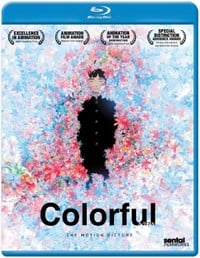Shelf Life
Color Theory
by Bamboo Dong,

Kids on the Slope complete collection BD
Colorful BD
Rental Shelf
Hanasaku Iroha set 1 Premium Edition BD+DVD
Perishable
Nothing this week
Welcome to Shelf Life.
 One part cute, one part elbow grease, and about three parts pure gumption, Hanasaku Iroha is a monument to hard work and the virtues of a strong work ethic. It's perhaps also a caution that workaholism kills any chance you have at a functional family life, but this is an observation reserved solely for the audience—when it comes to the many characters of Hanasaku Iroha, work is the only thing that drives their lives. Perhaps that's how the animators felt about their jobs as well; the series is absolutely gorgeous, with charming backgrounds and beautiful animation, both of which stand out even more when watched on Blu-ray. This is to be expected, though—after all, this is the Tenth Anniversary project of production studio P.A. Works, who worked on other slice-of-life shows like True Tears and Tari Tari, as well as the dark and grotesque thriller, Another.
One part cute, one part elbow grease, and about three parts pure gumption, Hanasaku Iroha is a monument to hard work and the virtues of a strong work ethic. It's perhaps also a caution that workaholism kills any chance you have at a functional family life, but this is an observation reserved solely for the audience—when it comes to the many characters of Hanasaku Iroha, work is the only thing that drives their lives. Perhaps that's how the animators felt about their jobs as well; the series is absolutely gorgeous, with charming backgrounds and beautiful animation, both of which stand out even more when watched on Blu-ray. This is to be expected, though—after all, this is the Tenth Anniversary project of production studio P.A. Works, who worked on other slice-of-life shows like True Tears and Tari Tari, as well as the dark and grotesque thriller, Another. While Hanasaku Iroha is a visual marvel, though, there are parts of the series that just… don't sit right. Characters' actions sometimes stray just a little too far out of the realm of logic, resulting in frustrating scenes that are more circus than drama. To give a little bit of background, main protagonist Ohana finds herself suddenly forced to make a big change in her life—her flighty, irresponsible mother, whom she already cooks for and cleans after, has decided to run away with her boyfriend. Ohana is sent to live with her grandmother out in the countryside, who owns a hot spring inn named Kissuiso. Although already accustomed to having to run the household, Ohana realizes that she'll have to work even harder to please her grandmother, and to earn her room and board at the inn. While there, she quickly makes an enemy—an apprentice chef named Minko, who also happens to be her roommate. There are lots of other colorful characters at Kissuiso, too, like the sleazy author whose penned fantasies provide the only whispers of fanservice in the series; gruff but talented junior chef Tohru, sweet attendant Nako, and a host of others. None, though, are quite as colorful as Ohana herself, who plunges into her job duties with zeal.
It's from her actions, though, that some of the more ridiculous scenes in Hanasaku Iroha are born. For as dedicated as Ohana is to her job, she's just as reckless and rash. When the inn is short-staffed, she vows to go into the city to track down Tohru, who's away for a friend's wedding. But, since she has the foresight and planning skills of a doorknob, she just barrels into the city's multi-room, multi-level wedding complex, frantically looking in at every wedding until she finds him. Presumably, there were better ways she could've handled this. Later in the series, when a mysterious freelancer writes a negative review of the inn, Ohana just skips town and heads into Tokyo, determined to discover the identity of—and confront—the writer. But really, for what reason? While scenes like the above two are good at illustrating how much Ohana is willing to sacrifice for her job… who even acts like this? Few of her plans are actually well thought-out, and although we, as the audience, are supposed to fall in love with her tenacity, I found her actions to be more frustrating and distracting than anything positive. In fact, most of the conflicts and resolutions in the series fall under this pattern—something bad happens for Kissuiso, Ohana does something reckless and half-brained, and things manage to somehow work out. It's simply too much of a sideshow at times, detracting from the otherwise charming and believable atmosphere of the series.
And yet, there are parts of the series that do work. It is uplifting to see Ohana change the lives of the other employees at Kissuiso. It's nice to see her force the other girls to warm up to her, although in almost every scenario, the series is unwaveringly on message about putting career first. It's a nice message, I guess, but one hopes that by the end of the series, Ohana and the rest of the women in her family realize that there is more to life than work.
Until then, just looking at the first thirteen episodes of Hanasaku Iroha, it's definitely worth watching. If anything, it's worth watching just for the animation alone, which is amazingly intricate. From the carefully drawn hands, to the movements of the characters' clothes and hair, the series is beautiful to watch. If you're a collector, too, the NIS America premium edition box is stunning, and the hardcover artbook inside is beautifully laid out. As far as the show goes, I found the frequent punctuations of inn-life by Ohana's ludicrous, mostly stupid actions to be detriment to the consistency of my enjoyment of the series. However, I don't think that should deter anyone from checking out the series. For the most part, it's beautiful and lovely, and a whole lot of fun.[TOP]
 Although not as beautiful, I got more enjoyment out of Kids on the Slope, which Sentai recently released on Blu-ray. What it lacks in fluttering cherry blossom petals and girls triumphantly shaking out futons, though, it makes up with in an incredible soundtrack (courtesy of Yoko Kanno).
Although not as beautiful, I got more enjoyment out of Kids on the Slope, which Sentai recently released on Blu-ray. What it lacks in fluttering cherry blossom petals and girls triumphantly shaking out futons, though, it makes up with in an incredible soundtrack (courtesy of Yoko Kanno). Directed by Shinichiro Watanabe (reuniting the director/composer dream team that colloborated on classics like Macross Plus and Cowboy Bebop), Kids on the Slope takes viewers back in time, to 1966. With the exception of a few scenes, though, in which real world events are actually referenced, one wouldn't necessarily be able to pinpoint the era in which the series takes place. The result is a show that feels wonderfully nostalgic, accompanied by a breezy, jazzy soundtrack that's neither overproduced, nor overworked. The series is a little slow, but it's never boring, and it allows the characters' relationships with one another to breathe.
We're first introduced to a transfer student named Kaoru, a shy boy who gets sick to his stomach when he has to interact with people. His only respite is going up to the school roof for fresh air, but there, he meets a delinquent named Sentaro who takes an immediate liking to him, much to his dismay. Sentaro, a talented drummer and jazz aficionado, discovers that Kaoru is a pianist, and introduces him to the world of jazz. Before long, a friendship is forged. Their trio is rounded out by Sentaro's childhood friend Ritsuko, and although there is a romantic subplot when Kaoru develops feelings for her, it's handled deftly, emphasizing the awkwardness of teen romance and mixed feelings. We also meet some other characters with complex backgrounds—an older guy whom Sentaro calls “Brother Jun” and idolizes, whose ties with a political movement estrange him from his family, and the girl who uproots her privileged life for him, as well as Kaoru's mother, who left him when he was younger. While all of those stories play out with bittersweetness, nothing quite compares to the highlights of the series—the times when Kaoru and Sentaro can leave everything behind and play music together. There's an unforgettable scene that takes place during the school festival talent show, one that must be experienced firsthand to actually appreciate.
Although the series looks great on Blu-ray, I don't know that it's really necessary. The scenes that benefit from it the most are the rotoscoped jam sessions, which are a welcome departure from your typical anime instrument-playing scene, in which lumpy hands float aimlessly over keys. Also included with the Sentai release is an English dub. It's fine, I guess. There aren't really any standout performances (although Blake Shepard's performance on the flamboyant Seiji deserves its chuckles), though there aren't really any instances where it falls flat, either. If I'm to nitpick, I would wish that someone would've told Ritsuko that “Kora” wasn't proper pronunciation of “Kaoru,” but it doesn't detract from the series. Maybe, also, I would've questioned Sentaro's slang usage of terms of “dude,” the first recorded instance (in this context) of which only occurred in the same year of 1966, and perhaps would not have reached Japanese shores yet. But really, those are just petulant whines, and overall, the dub is fine. Notably, Sentai made the choice(?) to not redub the in-series songs, so the scene where Ritsuko launches into an Engrish “My Favorite Things” is a little jarring, but there's a good chance this was a copyright issue, and out of their control.
If I were to have one gripe about the series overall, it's that I find the ending to be a little rushed. So much care is spent in the series building the characters, strengthening their relationships, and delving into their often painful family lives, that when one of the characters is suddenly taken away, only to be reunited in a time skip, it feels unfair. The seed for the character's departure could've been planted earlier; his rediscovery could've been dragged out longer. Even so, the ending is satisfying, purely from the point of view of the audience sentimentality. I don't think we, as a collective audience, could've handled one that didn't work out the way it did. [TOP]
Continuing the train to sentimentality, I rounded off my week with Colorful. No, not the ecchi series from 1999 (which I adore, by the way), but the film that premiered in 2010.
 Colorful takes a while to get off the ground. When it finally does, though, it's a wonderful work that's mostly uplifting and eye-opening, but a little… well, patronizing at times. It sees depression and suicide through an uncomfortably rosy lens, like the only thing that one needs to find happiness is a reset button. Yes, it does highlight the utmost importance of the emotional necessities in life, like a stable family life, and friends who care about you, and it does point out how often we take the presence of family members for granted, but it does so in an overly simplistic manner that dismisses depression as a passing trifle. But beneath it all, maybe it's trying to say that forgiveness is the only way to move on with life. I don't know, I'll leave that for individual viewers to decide.
Colorful takes a while to get off the ground. When it finally does, though, it's a wonderful work that's mostly uplifting and eye-opening, but a little… well, patronizing at times. It sees depression and suicide through an uncomfortably rosy lens, like the only thing that one needs to find happiness is a reset button. Yes, it does highlight the utmost importance of the emotional necessities in life, like a stable family life, and friends who care about you, and it does point out how often we take the presence of family members for granted, but it does so in an overly simplistic manner that dismisses depression as a passing trifle. But beneath it all, maybe it's trying to say that forgiveness is the only way to move on with life. I don't know, I'll leave that for individual viewers to decide.The film opens at a hazy train station, except the patrons are faceless figures. All except one—a grey-haired, bright-eyed boy who introduces himself as Purapura. He tells our protagonist that he's made a terrible mistake in his last life, but he's being given one last chance to redeem himself—assuming he can survive his home-stay punishment. Our lost soul is deposited in the body of a recently deceased boy name Makoto, who committed suicide. With the help of Purapura, he relearns the identities of the people in Makoto's life—his family members, his classmates—as well as the emotional struggles that he had. Although he can't figure out what kind of guy Makoto was, and does uncharacteristic things because of it, he decides to make the best of it, befriending a train otaku in his class. His “rehab” does have an expiration date, though. Purapura has warned him that if he can't figure out what his misdeed in his previous life was, he'll take Makoto's life away, permanently.
Despite “Makoto's” new personality, which nets him a friend and even an admirer, he still struggles at home. Upon learning of his mother's infidelity, he openly loathes her. It's not till the end of the movie, though, during a slightly contrived family dinner, that all the threads are tied together. It's when all the cards are laid on the table and we see the vulnerability of every character in the movie. We realize, just like Makoto realizes, that things like “family” have deep roots, regardless of what's on the surface. It's the film's shining moment, and even though the exposition dump feels a little forced—it's basically relying on one monologue to deliver the “Aha!”—it's moving and emotionally satisfying.
One thing I wanted to quickly point out, though, is that the music choices in Colorful are spot on. The movie knows how to use a score, and it uses it effectively. When Makoto's feeling good or brave, the music is loud, rollicking rock and roll. When he styles his hair in a more trendy, experimental way, we feel his changed emotional state through the music. It's things like that which enhance the viewing experience, and I found myself soaring and crashing alongside Makoto as he navigated the murky waters of his life.
Despite my reservation about parts of the movie, I do think it's worth watching. There are aspects of the movie that I found a little contrived, or a little too convenient—both in the setup of the movie, and the family dinner at the end—but the actual message of the movie and the sentiments behind it are solid. Ultimately, what I found lacking in the execution of the movie may just be a side-effect of time constraints. At 120-some minutes, the movie is long enough to deliver a satisfying story and show Makoto's growth as a person, but it takes some leaps and jumps in order to string together all the dots. Still, it's a good choice for a weeknight, and I highly recommend it.[TOP]
That's it for this week. Join me next week on The Stream for a look at this season's simulcasts!

This week's shelves are from Matt:
"Here are some photos of my shelf which I built with my own two hands :)
At first I was just collecting games, but then I saw pictures of shelves on shelf-life and was inspired to start my own collection. I am still trying to keep up with all the anime I buy XD"












Impressive collection already, and nice shelves!
Want to show off your stuff? Send your jpgs to [email protected]. Thanks!
discuss this in the forum (66 posts) |